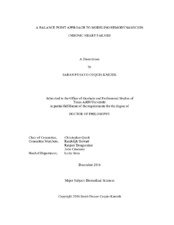| dc.description.abstract | Chronic heart failure is a complex disease state that can yield reduced cardiac output, pulmonary edema, and increased peripheral resistance. Pressures, flows, and volumes in these conditions emerge from the complex interaction of multiple mechanical properties of the cardiovascular system. The shear complexity of emergent behavior poses a challenge to both basic scientists, who use reductionist approaches to study subsystems in isolation, and clinical researchers, who use inductive approaches to infer the causes of observed changes in clinical variables. This dissertation instead takes a deductive approach using mathematical models to relate three critical cardiovascular variables impacted by heart failure (cardiac output, pulmonary interstitial pressure, and microvascular resistance) to mechanical properties of three subsystems of the cardiovascular system. In contrast to common modeling approaches, three strategies are employed to reduce the complexity and generalize results. First, systems are strategically lumped into descriptions that can be characterized empirically. Second, algebraic formulas are derived to generalize results. Third, the critical interaction of physiological subsystems is represented with opposing processes in the form of “balance points.”
The use of all three strategies allows us to: 1) quantify Guyton’s classic cardiac output-venous return graph, 2) predict pulmonary interstitial pressure from interaction of the heart, vascular, and lymphatic systems, and 3) characterize adaptation of the microvasculature to changes in pulsatile blood flow. Cardiac output and venous return curves can now be predicted from parameters characterizing the mechanical properties of the closed-loop system with chronic heart failure. The primary determinants of pulmonary interstitial pressure can now be identified for different phenotypes of heart failure. Finally, increased peripheral resistance, capillary rarefaction, and the formation of arteriovenous malformations are predicted with a decrease in the pulsatility of blood flow. Taken together, applying a physiological balance point approach to integrate subsystems clarifies how changes in the mechanical properties of the cardiovascular system impacts blood and interstitial pressures, volumes, and flows. | en |


